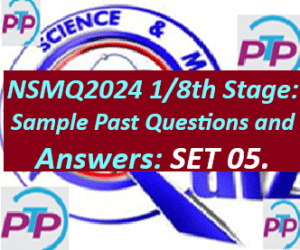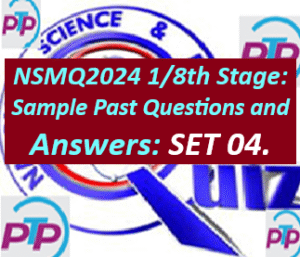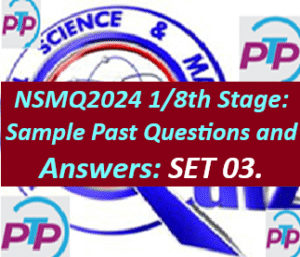NSMQ 2023 CHEMISTRY QUARTER FINAL QUESTIONS AND ANSWERS.

NSMQ 2023 CHEMISTRY QUARTER FINAL QUESTIONS AND ANSWERS.
SET 01
Preamble to all schools:
Consider the following elements, listed not in any particular order.
Beryllium, Argon, Silicon, and Sodium.
- Which of these elements has the lowest first ionization energy?
Ans: Sodium
- Which of these elements has the biggest atomic radius?
Ans: Argon
- Which of these elements is most electronegative?
Ans: Silicon
SET 02
- Why was VALCO, the first aluminum smelter company in Ghana, sited at Tema in the Greater Accra Region?
Ans: Sited at Tema to receive imported alumina through the Tema harbour, and also has an electricity supply from Akosombo.
- Why is the electrolysis of molten alumina preferred to the electrolysis of an aqueous solution of Al3+ ions in the commercial production of aluminum?
Ans: H+ ions in the aqueous solution will be discharged at the cathode in preference to the Al3+ ions, OR the reduction potential of H+ ions is higher than that of Al3+.
- Calculate the pH of a 0.100 moldm-3 solution of a sodium salt of an alkanoic acid whose pKa is 4.80.
Ans: pKb of the conjugate base = 14.0 – 4.80 = 9.20
pOH = ½ pKb – ½ log Cb (Cb = 0.100 moldm-3)
= 9.20/2 + 0.500
= 5.10
Hence pH = 14.0 – 5.10 = 8.90.
SET 03
Preamble to all schools:
In the commercial preparation of trioxonitrate(V) acid, nitrogen(IV) oxide dissolves in water to give the acid, while nitrogen(II) oxide is evolved. The balanced equation for the reaction is as follows:
3NO2 + H2O → 2HNO3 + NO.
O = 16.0; N = 14.0; H = 1.00.
The molar volume of a gas at STP is 22.4dm3.
- Calculate the mass of HNO3 that can be produced from 69.0g of NO2 gas.
Ans: 3NO2 + H2O → 2HNO3 + NO.
3 x 46.0 2 x 63.0
138g of NO2 ≡ 126g of HNO3
Therefore, the mass of HNO3 to be produced from 69.0g of NO2
= (69.0/138) x 126g
=63.0g
- Find the volume of NO2 at STP that can be used to produce 189g of HNO3.
Ans: 3NO2 + H2O → 2HNO3 + NO.
Moles of HNO3 in 189g of it. = 189/63.0 = 3.00
Moles of NO2 needed = (3.00/2.00) x 3 = 4.50.
Hence, the volume of NO2 at STP required
= 4.50 x 22.4 = 100.8dm3
= 101dm3
- Calculate the mass of the minimum amount of water required to react completely with 44.8 dm3 of NO2 at STP.
Ans: 3NO2 + H2O → 2HNO3 + NO.
Moles of NO2 in 44.8dm3 of the gas at STP = 44.8/22.4 = 2.00
Moles of water required = (1/3) x 2 = 2/3
Mass of water
= (2/3) x 18.0
= 12.0g
SET 04
- Which element has atoms with a bigger atomic radius, silicon or aluminum?
Ans: Aluminum
- Which element is relatively more electropositive, sulphur or selenium?
Ans: Selenium
- Which element has the higher first ionization energy, hydrogen or helium?
Ans: Helium
SET 05
- If the enthalpies of formation in kJmol-1 of 1-pentyne, 1-pentene, and pentane are +145, -21.0, and -147, respectively, calculate the enthalpy of hydrogenation of i) 1-pentyne to 1-pentene and ii) 1-pentene to pentane. Indicate which reaction is thermodynamically more favourable.
Ans: 1-Pentyne → 1-pentene
Δr = ΣΔH products – ΣΔH reactants
= -21.0 – (+145)
= -166kJ
1-Pentene → pentane
Δr = ΣΔH products – ΣΔH reactants
= -147 -(- 21.0)
= -126kJ
The reduction from 1-pentyne to 1-pentene is thermodynamically more favourable.
- If the enthalpies of formation in kJmol-1 of 2-pentyne, cis-2-pentene and trans-2-pentene are +129, -28.1, and -31.9, respectively, calculate the enthalpy change for the reduction of 2-pentyne to i) cis-2-pentene and ii) trans-2-pentene. Indicate which reaction is thermodynamically more favourable and give the reason for that relative order.
Ans: 2-Pentyne → cis-2-pentene
Δr = -28.1 – (+129) = -157kJ
2-Pentyne → trans-2-pentene
Δr= -31.9 – (+129) = -161kJ
Reduction to the trans compound is thermodynamically more favourable.
Reason: The trans compound is more stable/has lower internal energy
- If the enthalpies of formation in kJmol-1 of cis-2-pentene, trans-2-pentene and pentane are -28.1, -31.9, and -147, respectively, calculate the enthalpy change for the reduction i) cis-2-pentene to pentane and ii) trans-2-pentene to pentane. Indicate which reaction is thermodynamically more favourable and give the reason for that relative order.
Ans: cis-2-Pentene → pentane
Δr = -147 – (-28.1) = -119kJ
trans-2-Pentene → pentane
Δr = -147 – (-31.9) = -115kJ
Reduction of the cis compound is thermodynamically more favourable.
Reason: The cis compound is less stable/has higher internal energy.
SET 06
- Define a base according to the Lewis concept:
Ans: A base is an electron pair donor.
- Define an acid according to the Bronsted–Lowry concept
Ans: An acid is a proton donor.
- What are the usual constituents of a buffer solution?
Ans: A buffer solution will usually contain a weak acid and its conjugate base or a weak base and its conjugate acid.
SET 07
- If the half–life of a first-order reaction is 2.00 minutes, calculate the rate constant of the reaction.
Ans: t1/2 = 0.693/k
K = 0.693/2.00 x 60.0 = 5.78 x 10-3 s-1
- The decay constant of a radioactive substance is 6.60 x 10-3 s-1. Calculate the half–life of the substance.
Ans: t1/2 = 0.693/k
= 0.693/6.60 x 10-3 = 105 s or 1min 45s
- A radioactive substance has a half–life of 2.00 hours. What percentage of the initial activity will be left after 10.0 hours?
Ans: There are 5 half–lives in 10.0 hours.
0 – 2 – 4 – 6 – 8 – 10
50% 25% 12.5% 6.25% 3.13
So, the percentage left is 3.13% of the initial activity.
- The so-called batteries used in mobile phones are dry voltaic cells. What type of cells are they?
Ans: Secondary Voltaic Cells – (they can be recharged after they have been discharged)
- Consider the reversible reaction:
A(g) + 3 B(g) + heat ⇌ C(g) + D(g)
- At which of the following temperatures will the equilibrium constant be largest, 200oC or 300 oC, or 400 °C?
Ans: 400oC. (Le Chatelier’s Principle)
- Give the colour that a copper compound imparts to a colourless flame.
Ans: Green
SET 08
- Give the name of the first element and also the number of naturally occurring elements present in Group VI or 16 of the Periodic Table.
Ans: Oxygen; Five (5) elements
- What are the first and the last elements in Period 4?
Ans: Potassium and Krypton
- What is the atomic number of the last element in the first d-transition series?
Ans: 30 (20 +10) (Zinc)
SET 09
An organic acid HA has a dissociation constant Ka of 4.00*10-9. Calculate the concentration of A– ions in a 0.100 moldm-3 solution of the acid. Assume the amount of the acid that dissociates is negligible compared to its original concentration.
Ans: HA(aq) ⇌ H+(aq) + A-(aq);
But [H+(aq)] = [A–(aq)]
Ka = [A–(aq)]2/[HA(aq)]
[A–(aq)] = [(4.00 x 10-9)(1.00 x 10-1)]½ = 2.00 x 10-5 moldm-3
- Calculate the pH of a 0.100 moldm-3 solution of the conjugate base of methanoic acid, if the pKa of the acid is 3.76.
Ans: pKa + pKb(conjugate base) = 14.0
pKb(Conjugate base)
= 14.0 – 3.76
= 10.2
pOH = ½ pKb – ½ log Cb
= 5.10 + 0.500
= 5.60
Hence pH of the solution of the base
= 14.0 – 5.60
= 8.40
- If the pH of a 0.100 moldm-3 solution of a sodium alkanoate, NaX, is 9.20, calculate the pKa of the alkanoic acid HX.
Ans: pOH of the alkanoate solution = 14.0 – 9.20 = 4.80
But pOH = ½pKb (alkanoate) – ½logCb
Hence pKb
= 2 x 4.80 – 1.00
= 8.60
pKa of alkanoic acid
= 14.0 – 8.60
= 5.40
SET 10
- What is the name of a saturated hydrocarbon with 12 carbons in a chain?
Ans: Dodecane.
- Calculate the number of moles of limestone (CaCO3) in a 2.00 kg gold ore that contains only 0.500% gold, the rest being CaCO3 in the form of limestone.
Ca = 40.0; O = 16.0; C = 12.0
Ans: Mass of limestone
= (2000 – 10.0)
= 1990
The formula mass of limestone
= 40.0 + 12.0 + 48.0
= 100
Moles of limestone
= 1990/100
= 19.9 mol.
- Which flask is needed to perform suction filtration in the laboratory?
Ans: (Heavy wall) filtering flask.
SET 11
- Name the source of heating that will be used in the fractional distillation of two liquids whose boiling points are about 45 °C and 55 oC, respectively.
Ans:
Electric heating mantle OR
A water bath on ( an electrically heated) hot plate OR.
A water bath heated with a Bunsen burner under an asbestos mat.
- Name the piece of glassware that must be present in a setup for heating a liquid mixture under reflux.
Ans:
(Water) Condenser
- Name the piece of glassware suitable for the preparation of a bulk solution of accurately known concentration.
Ans: Volumetric Flask
SET 12
- When solid KMnO4 is heated K2MnO4, MnO2, and oxygen gas are formed. Give a balanced equation for the reaction.
Ans:
- KMnO4 → K2MnO4 + MnO2 + O2(g)
- What is the difference between hard water and heavy water?
Ans:
Hard water is water in which soap does not lather easily, whilst heavy water is liquid D2O or deuterium oxide.
- Name the isomeric alkene or alkene of 1-pentene that will show cis-trans isomerism.
Ans:
2-Pentene
SET 13
- 18.0dm3 of nitrogen gas at a pressure of 120 kPa is compressed to a pressure of 160 kPa at a constant temperature. Calculate the new volume.
Ans:
V1 = 18.0 dm3;
P1 = 120 kPa;
P2 = 160 kPa;
V2 = ?
P1V1 = P2V2;
V2 = (P1/P2)*V1
V2 = (120/160) x 18.0
= 13.5 dm3
- The volume of oxygen gas obtained in an experiment at 27oC is 3.90 dm3. What would have been the volume of the oxygen obtained if the room temperature had been 37 °C? Assume the pressure of the gas was constant.
Ans:
V1 = 3.90 dm3;
T1 = (27 + 273)
= 300
T2 = (273 + 37)
= 310;
V2 = ?
From Charles’ law,
V1/T1 = V2/T2;
V2 = (T2/T1)*V1
V2 = (310/300) x 3.90
= 4.03dm3.
- A balloon contains 16.5dm3 of neon at 27.0 °C and 100 kPa. If the gas is heated to 72.0 °C while the pressure in the balloon increases to 115 kPa, calculate the volume of the balloon under these conditions.
Ans:
Using the combined Boyle’s and Charles’ Laws
P1V1/T1 = P2V2/T2;
V2 = (P1/P2) x (T2/T1) x V1
P1 = 100 kPa;
P2 = 115 kPa;
T1 = (27.0 + 273)
= 300 K;
T2 = (72.0 + 273)
= 345 K
V2 = (100/115) x (345/300) x 16.5
= 16.5dm3 .
SET 14
Preamble to all schools
Consider the following reversible chemical reaction:
A(g) + 2B(g) ⇌ 3C(g);
ΔHr = -230kJ
- How will an increase in temperature affect the equilibrium constant?
Ans:
Keq will decrease since the forward reaction is exothermic.
- At equilibrium, how will an increase in volume affect the equilibrium position?
Ans:
Since the number of gaseous reactant molecules is the same as the products, the equilibrium position will not be affected by changes in volume.
- How will the addition of a catalyst affect the equilibrium constant?
Ans:
The equilibrium constant will not be affected by the addition of a catalyst.
SET 15
Preamble to all schools:
An organic compound A decomposes by second-order kinetics. The integrated form of the second-order rate equation is 1/[At] = kt + 1/[A0], where [A0]is the initial concentration of A and [At]is its concentration at time t.
- Calculate the rate constant if 10.0% of the initial concentration of 0.100 moldm-3 of A is decomposed after 50.0 seconds. Remember to give your answer in the standard or scientific form.
Ans:
1/[At] = kt + 1/[A0]
Concentration of A after 50.0 s = 0.0900moldm-3.
1/0.0900 = k x 50.0 + 1/0.100;
11.1 = 50.0k + 10.0
K = 1.10/50.0
= 1.10/50.0
= 2.20 x 10-2 mol-1dm3s-1
- Calculate the rate constant if in another reaction 60.0% of the 0.100 moldm-3 of A had decomposed in 150 seconds. Give your answer in the standard form.
Ans:
1/[At] = kt + 1/[A0]
1/0.0400 = k x 150 + 1/0.100;
25.0 = 150k + 10.0
k = 15.0/150
= 1.00 x 10-1 mol-1dm3s-1
- For another decomposition reaction of A, determine the time in seconds it takes 50.0% of the initial concentration of 0.100 moldm-3 of A to decompose if the rate constant of that reaction is found to be 2.00 X 10-2 mol-1dm3s-1
Ans:
1/[At] = kt + 1/[A0]
1/0.0500 = k*t + 1/0.100;
20.0 = 2.00*10-2t + 10
t = 10.0/2.00*10-2
= 500s (or 8min 20s)
[Alternative method: Time for 50% of the concentration to be consumed is t½.
But for a second-order reaction, t½ = 1/k[A0]
t½ = 1/2.00*10-2*0.100 = 1.00*103/2 = 500s ]
SET 16
- What is the name of the energy required to produce oxygen atoms from oxygen molecules at standard temperature and pressure?
Ans:
Standard enthalpy/heat of atomization.
Note: ½O2 → O atomization
O2 → 2O dissociation
- What do we call isomers that affect the plane of polarized light to the same extent but in the opposite direction?
Ans:
Enantiomers (Do not accept optical isomers.)
- A metal M of atomic mass 51.0 forms an oxide containing 44.0% oxygen. What is the empirical formula of the metal? O = 16.0
Ans:
% Metal in the oxide = 100 – 44.0 = 56.0
M O
56.0/51.0 44.0/16.0
1.10 2.75
1: 2.50
2: 5
Empirical formula = M2O5
SET 17
- Explain the process of ‘Radioactive decay’.
Ans:
It is the spontaneous disintegration of a radioactive nucleus to give a daughter nucleus or daughter nuclei and radiation (or nuclear particles)
- Some radioactive nuclei decay by α-emission. What is the process equivalent to?
Ans:
It is a loss of atomic mass units of 4 and an atomic number of 2, or loss of a helium nucleus.
- By what means can a non-radioactive nucleus be made to disintegrate?
Ans:
By bombardment of the nucleus with (energetic) nuclear particles.
SET 18
- Calculate the percent oxygen by mass in magnesium trioxocarbonate(IV).
Mg =24.0 O = 16.0; C = 12.0
Ans:
MgCO3 = 24.0 + 12.0 + 48.0
= 84.0
%O = (48.0/84.0)*100
= 57.1%
- Calculate the percent carbon by mass in sodium trioxocarbonate(IV).
Na = 23.0, O = 16.0; C = 12.0
Ans:
Na2CO3 = 46.0 + 12.0 + 48.0
= 106
%C = (12.0/106)*100
= 11.3%
- Calculate the percent calcium by mass in calcium trioxocarbonate(IV).
Ca = 40.0; O = 16.0; C = 12.0
Ans:
CaCO3 = 40.0 + 60.0
= 100
%Ca = (40.0/100)*100
= 40.0%
SET 19
Preamble to questions (1) and (2).
Consider the reversible reaction given below:
2A (g) + B(g) 2C(g) + 3D (g)
- Give the expression for the Kc of the reaction when it is in equilibrium.
Ans:
Kc = [C]2[D]3/[A]2[B]
- Give the relationship between the Kc and Kp of the reaction
Ans:
Kp = Kc(RT)∆n where ∆n is the difference in the number of gaseous products and gaseous reactants. Δn = 2
Therefore, Kp = Kc(RT)2 OR Kc = Kp(RT)-2
- Give the products of decomposition when solid lithium trioxonitrate(V) is heated.
Ans:
Lithium oxide (Li2O) and nitrogen(IV) oxide (NO2)
SET 20
- Give the difference between vaporization and sublimation.
Ans:
Vaporization refers to the change of a solid or liquid to the vapour/gaseous phase, but Sublimation refers specifically to the change from solid to vapour/gaseous phase (without passing through the liquid phase)
- What benefits are derived from the Kinetic Theory of gases?
Ans:
It tries to explain the simple relationships among the physical properties of gases.
- Name the four parameters or properties that are related in the Ideal Gas Law.
Ans:
Pressure (P), Volume (V), Temperature (T), and Molar quantities (n)
(i.e. PV = nRT)
SET 21
- 2.00 kg of bauxite after processing yields 714 g of alumina. What is the percentage of aluminum in the bauxite, assuming the processing does not lead to any loss of alumina?
Al = 27.0, O = 16.0
Ans:
Alumina = Al2O3 = 54.0 + 48.0 = 102
Mass of Al in 714g of alumina = (54.0/102)*714 = 378 g.
%Al in bauxite = (378/2000)*100 = 18.9%
- A gold-bearing rock is found to contain 3.14*10-2 percent of gold. How many grams of gold can be obtained from 15.0 kg of the rock, assuming the processing is 100% efficient?
Ans:
Mass in kg of gold in 100kg of rock
= 3.14*10-2 kg ≡ (3.14*10-2*103) g
Mass in g of gold in 100kg of rock
= 31.4 g of gold
Therefore, the mass in g of gold in 15.0 kg of rock
= (15.0/100)*31.4
= 4.71g.
- Chromium may be obtained by reduction of its oxide Cr2O3 with carbon at high temperatures. If 760 g of impure oxide yields only 416 g of chromium, what is the percentage purity of the oxide?
Cr = 52.0; O = 16.0
Ans:
Cr2O3 = 104 + 48.0 = 152;
Hence , 152 g of Cr2O3 ≡ , 104 g of Cr
Therefore, 760g of pure Cr2O3 ≡ (760/152)*104
= 520 g Cr
Therefore, % purity = (416/520)*100
= 80.0%
SET 22
- Equal volumes of CO2 and an unknown gas at the same temperature and pressure have masses of 5.50g and 4.00g, respectively. Determine the molar mass of the unknown gas.
Ans
Use Avogadro’s Hypothesis: Let the molar mass of the gas be M.
Equal volumes at the same pressure and temperature contain the same number of moles,
Moles of CO2 = 5.50/44.0;
Moles of unknown gas = 4.00/M
Hence M = (44.0/5.50)*4.00
= 32.0
- State the expected observation when an alkanoic acid is tested with NaHCO3 solution and explain the chemistry of the test.
Ans:
Observation: Effervescence is observed
Chemistry: The alkanoic acid protonates the HCO3– ion to give H2CO3, which decomposes to CO2 gas and H2O.
- Name the metalloids in the fourth period of the Periodic Table.
Ans:
Germanium (Ge) and Arsenic (As).
SET 23
- The sulphur content in petroleum products is an important factor in determining the quality of the products. Why?
Ans:
High sulphur in a petroleum product translates into high SO2 emissions.
SO2 corrodes metal parts and also causes acid rain.
- Name one compound normally found in crude oil that may be the source of sulphur in a petroleum product.
Ans:
i)Hydrogen sulphide or
ii)sulphur(IV) oxide or
iii) thiols( also known as mercaptans) or
iv) thiophene or
v) benzothiophene or
vi) dibenzothiophenes.
3. What role does a Reforming Unit play in an oil refinery?
Ans:
It converts alkanes into alkenes and aromatic hydrocarbons, which have higher octane numbers.
SET 24
Consider the following bond energies, all in kJmol-1:
C – C 345; C = C 610; C – H 410; C – O 360; C = O 805; H – H 435; O – H 465.
- Calculate the enthalpy change for the formation of the necessary bonds in the reduction of 1-butene to butane by hydrogen gas.
Ans:
CH2=CHCH2CH3 + H2 → CH3–CH2CH2CH3
Bonds formed = C–C and 2C–H;
Enthalpy change = -345 + – 410*2
= -1165 kJ or -1.17*103kJ
- Calculate the energy required to break the necessary bonds during the reduction of 1-butene to butane by hydrogen gas.
Ans:
CH2=CHCH2CH3 + H2 → CH3–CH2CH2CH3.
Bonds broken = C=C and H2;
Energy required = 610 + 435
= 1045 kJ or 1.05*103kJ.
- Calculate the enthalpy change for the formation of the necessary bonds in the reduction of propanone to 2-propanol with hydrogen gas
Ans:
CH3COCH3 + H2 → CH3CHOHCH3
Bonds formed = C–O, C–H, and O–H
Enthalpy change = -360 + (- 410 ) + (- 465)
= -1235 or -1.24*103 kJ.
SET 25
- Why is phenol acidic?
Ans:
The conjugate base/the phenoxide ion is stabilised by resonance.
- Which of the following six graphs would not give a straight line for an Ideal Gas, other parameters remaining constant?
i) V versus P; ii) T versus P; iii) V versus T; iv) P versus 1/V; v) n versus 1/T; and vi) n versus 1/P.
Ans:
i) V versus P; and vi) n versus 1/P
3. Calculate the pressure in an evacuated 500 cm3 container at -33 °C when 4.00g of liquid oxygen is introduced into it and allowed to evaporate. The Ideal Gas constant is 8.31JK-1mol-1. O = 16.0
Ans:
The Ideal Gas equation may be used.
P = nRT/V.
Mol of O2 = 4.00/32.0;
T = 240K; V = 0.500dm3.
Pressure in the container P
= [(1/8)*8.31*240]/0.500
= 499kPa.
SET 26
Why did Rutherford and his team choose gold for the foil in the α-particle scattering experiment?
Ans:
Gold is the most malleable metal and can be beaten into very thin sheets/ foils.
Atoms of gold have heavy nuclei, and the chances of the α-particles encountering them are high.
- Which observation led the team to be able to describe the nature of the nucleus of the gold atom?
Ans:
That some of the α-particles were deflected back (or bounced back)
- What other observation or observations led the team to conclude that the mass that α-particles collided with and bounced back constituted the nucleus
Ans:
A few of the α-particles were deflected through small angles, suggesting that they travelled close to a positively charged unit
SET 27
Preamble to all schools:
When SOCl2 reacts with water, gaseous HCl and trioxosulphate(IV) are produced, and the balanced equation for the reaction is as follows:
SOCl2 + 2H2O → H2SO3 + 2HCl.
Cl = 35.5; S = 32.0; O = 16.0. Molar volume of gas at STP is 22.4dm3.
- Calculate the volume of HCl at STP that can be obtained from 35.7g of SOCl2.
Ans:
SOCl2 + 2H2O → H2SO3 + 2HCl.
Volume of HCl at STP from 35. 7g SOCl2
= (35.7/119)*44.8
= 13.4dm3.
- Calculate the mass of SOCl2 that needs to be hydrolysed to obtain 8.96dm3 of HCl gas at STP.
Ans:
SOCl2 + 2H2O → H2SO3 + 2HCl.
Mass of SOCl2 needed.
= (8.96/44.8)*119
= 23.8g
- Calculate the mass of SOCl2 that needs to be hydrolysed so that the HCl produced dissolves completely in 250cm3 of water to give a 2.00moldm-3 solution.
Ans:
SOCl2 + 2H2O → H2SO3 + 2HCl.
Mol of HCl required
= (250/1000)*2.00
= 0.500
Mol of SOCl2 that has to react
= 0.250
Mass of SOCl2 needed
= 0.250*119
= 29.8g
SET 28
- Why is it necessary to have iron and steel articles sometimes plated with chromium?
Ans:
i) Chromium is not easily affected by the atmosphere, unlike iron, which easily rusts;
ii) It gives those articles a lustrous or shiny appearance.
2. A sealed vessel at a pressure of 450 kPa contains 4.00 moles of nitrogen, 5.00 moles of oxygen, and 6.00 moles of argon. Determine the partial pressure of the nitrogen gas.
Ans:
Mole fraction of N2 = 4.00/15.0
Partial pressure of N2 = (4.00/15.0)*450
= 120kPa
- If chlorine has the atomic number 17, then what is the atomic number of chromium?
Ans:
- [17 + 1 → inert gas; + 2 →Groups I and II; + 4 → 4th transition member]
SET 29
- For the analyses of a mixture of Na2CO3 and NaHCO3 in a solution, which indicator will enable the concentration of the Na2CO3 to be determined in only one set of titrations?
Ans:
Phenolphthalein.
- Which of the pH indicators, phenolphthalein or methyl orange, will be appropriate for the titration of dilute ethanoic acid solution vs dilute sodium hydroxide?
Ans:
Phenolphthalein
- Which of the pH indicators, phenolphthalein or methyl orange, will be suitable for hydrochloric acid – sodium hydroxide titration?
Ans:
Either of the two will be suitable. ( If only one choice, one mark)
SET 30
- Two half-cells, A+/A and B+/B, have the electrode potentials 0.600V and -0.550V, respectively. Give the cell reaction of a cell that can generate electricity and its initial emf.
Ans:
Anode: B – e → B+ +0.550V
Cathode: A+ + e → A 0.600V
Cell reaction: B + A+ → B+ + A
Emf= 1.15V
- Two half-cells, C+/C and D+/D, have electrode potentials -0.430V and -0.850V, respectively. Give the equation for the reaction of the cell that can be created from the half-cells and calculate its initial emf.
Ans:
Anode: D – e → D+ +0.850V
Cathode: C+ + e → A -0.430 V
Cell reaction: D + C+ → D+ + C
Emf = +0.420V
- Two half-cells, E2+/E and F+/F, have electrode potentials +0.700V and +0.260V, respectively. Calculate the initial emf of a cell that can be created from the half-cells and give the equation for the cell reaction.
Ans:
Anode: F – e → F+ -0.260V ….(1)
Cathode: E2+ + 2e → E +0.700 V ….(2)
Multiply (1) by 2 and add to (2)
Cell reaction: 2F + E2+ → 2F+ + E
Emf = +0.440V
SET 31
- A gas cylinder at 28 °C contains 4.00 mol of oxygen gas, 3.50 mol of carbon(IV) oxide, and 3.50mol of nitrogen gas. If the total pressure is 330kPa, how many mol of argon gas can be added to raise the pressure to 380kPa at the same temperature?
Ans:
Total mol of gases originally present = 11.0
Since the gases do not react, the pressure exerted by each mole of gas
= 330/11.0
= 30.0kPa
Mol of argon needed
= (380 -330)/30.0
= 1.67mol
- State the main factor that is responsible for the variation of the first ionization energy down a Group of the Periodic Table.
Ans:
Increase in the atomic size down the Group.
- State the postulate of the Kinetic Theory of Gases that best explains the fact that the pressure exerted by a gas is uniform throughout its container.
Ans:
Molecules move randomly in straight lines in all directions and at various speeds.
SET 32
- Give the first step of the reaction mechanism for the chlorination of butane in the presence of light.
Ans:
Dissociation of a chlorine molecule into free radicals or chlorine atoms, each with an unpaired electron.
- Explain what happens in a chain-terminating step.
Ans:
Two free radicals, at least one of them involved in the chain propagating step, come together to form a neutral compound that is not a free radical.
- How many dichlorobutanes can be formed in the free radical reaction of butane and chlorine gases, such that the two chlorine atoms are not located on the same carbon? Name any two of them.
Ans:
Four.
Any two of:
1,2-dichlorobutane;
1,3-dichlorobutane;
1,4-dichlorobutane;
2,3-dichlorobutane
SET 33
- Two sparingly soluble metal hydroxides, MOH and Q(OH)2, have solubility products of 9.00*10-14 and 1.08*10-19, respectively. Find the solubility of each hydroxide and indicate which is more soluble.
Ans:
Solubility of MOH = √(9.00*10-14) = 3.00*10-7 moldm-3.
Solubility of Q(OH)2 = ∛(108/4*10-21) = 3.00*10-7 moldm-3
Hence, they are of equal solubility.
- Some radioactive nuclei decay by beta emission. What is the process equivalent to, and how does it affect atomic and mass numbers?
Ans:
It is equivalent to the conversion of a neutron to a proton in the nucleus. Hence, the atomic number of the new nuclide increases by one while the mass number remains the same.
- What is the discipline ‘Thermodynamics’ about?
Ans:
It is the science or study of the relationship between heat energy and other forms of energy.
SET 34
Preamble to all schools
Consider the following results of a kinetic experiment involving the reaction:
2A + 2B → 3C
| Experiment | Conc. of A /moldm-3 | Conc. of B/moldm-3 | Rate(moldm-3s-1) |
| 1 | 0.0300 | 0.0300 | 7.20*10-4 |
| 2 | 0.0600 | 0.0300 | 2.88*10-3 |
| 3 | 0.0600 | 0.0600 | 5.76*10-3 |
- Determine the order of the reaction with respect to A.
Ans:
Consider Experiments (1) and (2).
Doubling the concentration of A, while keeping the concentration of B constant, the rate increases by a factor of 4.
Hence, the reaction is second order with respect to A.
- Determine the order of the reaction with respect to B.
Ans:
Consider Experiments (2) and (3).
Keeping the concentration of A constant while doubling the concentration of B increases the rate by a factor of 2.
Hence, the order of the reaction with respect to B is first order.
- The reaction is second order with respect to A and first order with respect to B. Use this information and the results of Experiment 1 to calculate the rate constant of the reaction.
Ans:
Rate = k [A]2[B]
7.20*10-4 = k [3.00*10-2]2[3.00*10-2]
7.20*10-4 = k [2.70*10-5]
K = 7.20*10-4/2.70.*10-5
= 2.67*101 mol-2dm6s-1
(Full marks may be awarded even if no units are given.)
SET 35
- How many d-electrons does an element with atomic number 25 possess?
Ans:
5 d-electrons
[25 ≡ 1s22s22p63s23p64s23d5]
- How many p-orbitals will be occupied with paired electrons in an element with atomic number 15?
Ans:
3 p-orbitals
[15 = 1s22s22p63s23p3]
- Which Period in the Periodic Table will the element with atomic number 34 belong?
Ans:
Period 4
32 = Period1 (1s2) Period2 (2s22p6) Period 3 (3s23p6) Period4 (4s23d104p4)








